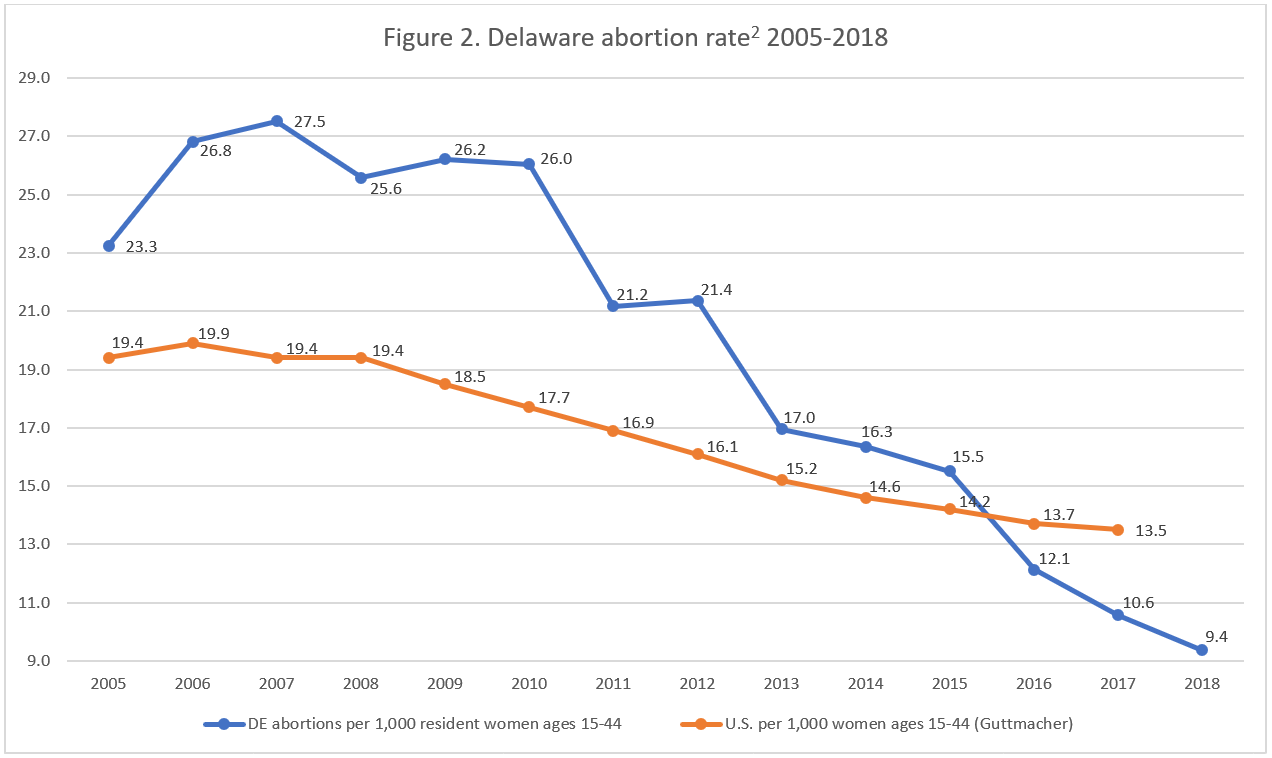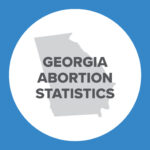Abortion Reporting: Delaware (2018)

Delaware’s 2018 abortion report, published online by the Delaware Department of Health and Social Services in December 2019, shows that abortions in the state continue to decline.
Changes in Delaware Abortions, 2017-2018

Information on Planned Parenthood’s Delaware market share is not publicly available.
Abortion Totals and Trends
There were 1,684 abortions reported in Delaware in 2018, down 11 percent from the 1,890 reported the previous year (Fig. 1). Of the abortions reported in 2018, there were 805 (48 percent of the total) chemical abortions. Chemical abortions decreased by 12 percent from 2017. The Charlotte Lozier Institute calculates that Delaware’s 2018 abortion rate was 9.4 abortions per 1,000 women of childbearing age, below the national rate (Fig. 2).
State Report Summary
Eighty-six percent of the abortions reported in Delaware were performed on state residents. Fourteen percent were performed on nonresidents, including six percent on women from Maryland, five percent on women from Pennsylvania, and one percent on women from New Jersey. Not quite one percent of the abortions were on women from other states besides these three.
Twelve percent of the abortions were performed on girls under the age of 20, of whom four girls were younger than 15. Thirty percent of the abortions were on women ages 20 to 24 and 27 percent on women ages 25 to 29, for a total of 57 percent of Delaware abortions performed on women in their twenties. Twenty-eight percent were on women in their thirties, with 18 percent on women ages 30 to 34 and 10 percent on women ages 35 to 39. Three percent of the abortions were performed on women age 40 and older.
White women underwent just under 50 percent of the abortions reported in Delaware, while 45 percent were performed on black women. Two percent of the abortions were on Asian or Pacific Islander women, just a tenth of a percent on American Indian women (two abortions), and three percent on women of other races. Delaware also reports ethnicity separate from race; 88 percent of the abortions were on non-Hispanic women, 11 percent on Hispanic women, and not quite one percent on women of unknown ethnicity.
Nine percent of the abortions were performed on women with less than a high school education. More than half (51 percent) were on women who had graduated from high school, and 17 percent were on women who had completed one to three years of college. An additional 14 percent had finished four or more years of college. Nine percent of the abortions were on women whose level of education was unreported.
A high majority, 88 percent, of the abortions reported in Delaware were performed on single women, with just 12 percent performed on married women. Two-thirds of the women had been pregnant before. Twenty-one percent had one pregnancy prior to this one, and 47 percent had two or more. Fifty-six percent of the women had previously had a live birth, with 24 percent with one previous live birth and 32 percent with more than one. Conversely, most women (63 percent) had never had a previous abortion. Twenty-three percent had one prior abortion, and 13 percent had two or more previous abortions.
Eighteen percent of Delaware abortions were performed earlier than seven weeks of gestation. Thirty-three percent occurred between seven and eight weeks, and 26 percent were performed between nine and 10 weeks. Eleven percent were performed at the end of the first trimester between 11 and 12 weeks of gestation. Nine percent of the abortions occurred between 13 and 15 weeks, and two percent were performed from 16 to 20 weeks of gestation. Half a percent, nine abortions, were performed at 21 weeks of gestation or later.
More than half the abortions reported in Delaware (52 percent) were performed using suction curettage. Forty-eight percent were chemical abortions, as noted above. There were no instillation abortions reported in 2018. One abortion was performed using another, unspecified method, and three were performed via unknown methods. The state does not report the number of abortions performed at each Delaware abortion facility, but Planned Parenthood of Delaware’s last published annual report (for fiscal years 2011 and 2012) suggests that Planned Parenthood is responsible for a large percentage of Delaware abortions.
Delaware’s Falling Abortion Rate
A recent report from the Guttmacher Institute features Delaware as the state with the greatest decrease in its abortion rate from 2011 to 2017. Multiple factors have likely contributed to this ongoing decline, but the fact that fewer women are traveling to Delaware for abortions and more Delaware residents are heading out-of-state no doubt played a role in lowering Delaware’s in-state abortion rate.
Between 2008 and 2017, the number of nonresident women traveling to Delaware for abortions declined by 83 percent, dropping from 1,296 nonresident abortions in 2008 to 223 in 2017. Over that same decade, abortion reports from neighboring states show that the number of Delaware residents who traveled out of state to undergo abortions increased. Reports from New Jersey and Pennsylvania together show a 200 percent increase between 2008 and 2017 in abortions on Delaware residents who traveled to these two states, even though not all New Jersey abortion providers are required to report abortions to the New Jersey Department of Health. These changing patterns may be partially attributable to the unsafe conditions and licensing troubles at several Delaware abortion centers.
State Ranking
In 2016, Delaware was ranked at 36th place by CLI’s study of abortion reporting across the county. The First State could improve its reports by including information on the percentage of abortions performed at each facility in the state and whether any abortions resulted in complications, information that is particularly pertinent as substandard abortion center conditions have put Delaware women at risk. Delaware could also require doctors to report whether any of the late-term abortions performed in the state resulted in babies being born alive.


- Delaware did not report the number of chemical abortions performed in 2009 and 2010.
- Starting with the 2018 abortion reports, abortion rates are calculated by the Charlotte Lozier Institute to allow for easier state-to-state and year-to-year comparisons. Rates were calculated by CLI using population estimates from the United States Census Bureau. The rates were calculated using the following formula: (total number of abortions performed in Delaware ÷ number of resident women ages 15-44) x 1,000. Rates may differ slightly from previous CLI articles due to revised population estimates.

























